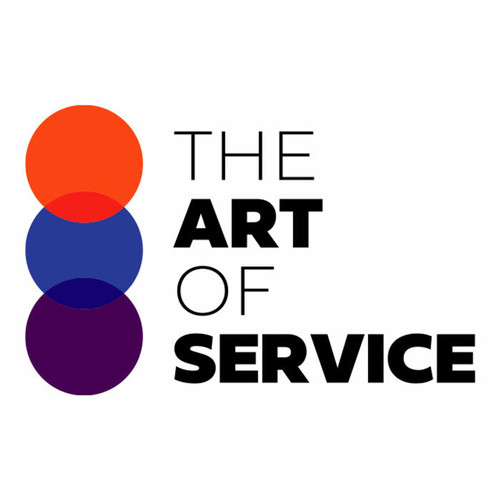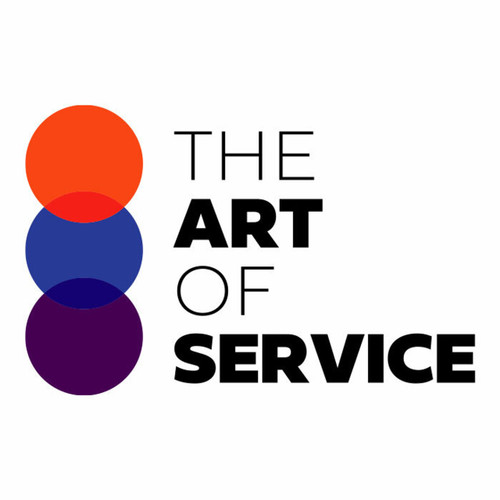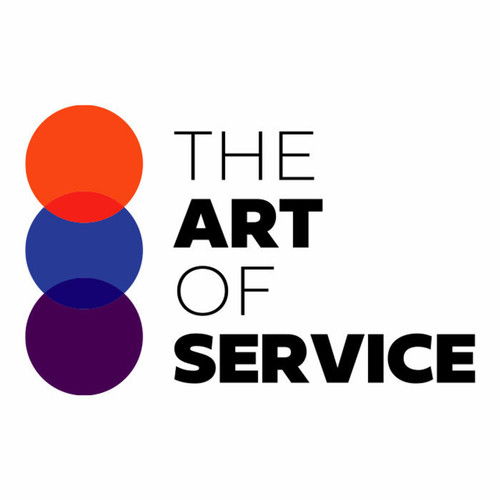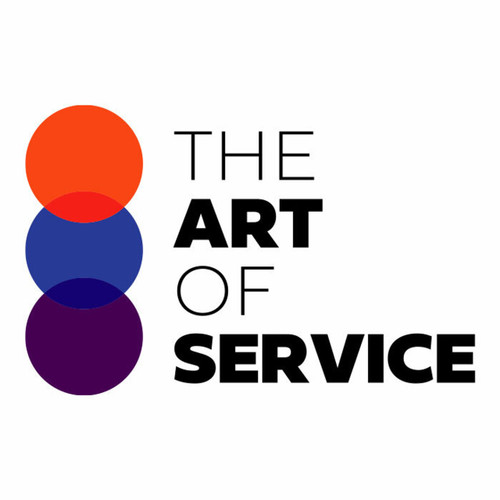Our carefully curated dataset consists of 1544 prioritized requirements, solutions, benefits, results, and even real-life case studies/use cases.
This comprehensive database has been designed to help professionals like you streamline their processes and achieve maximum efficiency and productivity.
Compared to other alternatives and competitors, our ITIL Framework and HR Shared Service Center Tools Knowledge Base stands out as the ultimate solution.
It caters specifically to professionals in the industry, providing precise and relevant information that is essential for success.
With detailed product specifications and an easy-to-use interface, our Knowledge Base makes it simple to find the exact information you need.
Unlike other products in this space, our ITIL Framework and HR Shared Service Center Tools Knowledge Base is an affordable and DIY option.
Say goodbye to expensive consultants and time-consuming research, and hello to a DIY solution that still delivers excellent results.
But that′s not all – our Knowledge Base also offers incredible benefits.
From increasing operational efficiency to reducing costs, our product is guaranteed to bring positive impacts to your business.
Don′t just take our word for it, our research on ITIL Framework and HR Shared Service Center Tools speaks for itself!
Whether you′re a small business or a large corporation, our ITIL Framework and HR Shared Service Center Tools Knowledge Base is suitable for businesses of all sizes.
And with a clear breakdown of costs, pros and cons, and a description of what our product can do, you can make an informed decision about investing in our product.
Don′t waste any more time trying to find the right information – let our ITIL Framework and HR Shared Service Center Tools Knowledge Base do the work for you.
Give your business the competitive edge it needs and streamline your processes with our comprehensive and affordable dataset.
Try it out now and see the difference for yourself!
Discover Insights, Make Informed Decisions, and Stay Ahead of the Curve:
Key Features:
Comprehensive set of 1544 prioritized ITIL Framework requirements. - Extensive coverage of 80 ITIL Framework topic scopes.
- In-depth analysis of 80 ITIL Framework step-by-step solutions, benefits, BHAGs.
- Detailed examination of 80 ITIL Framework case studies and use cases.
- Digital download upon purchase.
- Enjoy lifetime document updates included with your purchase.
- Benefit from a fully editable and customizable Excel format.
- Trusted and utilized by over 10,000 organizations.
- Covering: Drug Screening, Customer Satisfaction, Change Enablement, Diversity And Inclusion, Payroll Processing, Employee Self Service, Performance Optimization, Release Management, Problem Management, Knowledge Management, Contingent Workforce Management, Time And Attendance, Stakeholder Management, HR Advisory, ITIL Framework, Productivity Issues, Cloud Computing, Supplier Management, Background Checks, Customer Needs Analysis, Case Management, Capacity Management, Risk Share Agreement, Chatbot Integration, Information Security Management, HR Investigations, Artificial Intelligence, Performance Metrics, Labor Relations, Employee Engagement, Service Level Management, HR Business Partner Model, Lean Finance, Policy Management, Employee Directory, Applicant Tracking, Process Automation, Workflow Management, Incident Management, Training Management, Service Delivery, Employee Relations, SLA Reporting, Vendor Management, Cost Allocation, Supplier Quality, Disaster Recovery, HR Service Desk, Availability Management, HR Policies And Procedures, Demand Management, Business Continuity, Benefits Administration, Continuous Improvement, Talent Acquisition, Mobile Access, Training Delivery, HR Services, Process Efficiency, Compliance Management, Data Privacy, Root Cause Analysis, IT Systems, Workforce Analytics, Communication Planning, Third Party Providers, Robotic Process Automation, Compensation Management, Change Management, Service Request Management, Performance Management, Capacity Planning, HR Shared Service Center Tools, Succession Planning, Service Catalog, Systems Review, Low Hierarchy, Service Level Agreements, Continual Service Improvement, User Adoption
ITIL Framework Assessment Dataset - Utilization, Solutions, Advantages, BHAG (Big Hairy Audacious Goal):
ITIL Framework
ITIL framework often integrates with other standards like ISO 20000, COBIT, PRINCE2, and Six Sigma for holistic IT service management.
1. COBIT (Control Objectives for Information and Related Technologies): Provides a framework for IT management and IT governance. Benefit: Enhances control over IT services.
2. Six Sigma: A data-driven approach to eliminate defects and reduce variability in processes. Benefit: Improves service quality and efficiency.
3. PRINCE2 (Projects IN Controlled Environments): A project management methodology. Benefit: Standardizes project management, leading to better project outcomes.
4. Lean IT: Focuses on minimizing waste and maximizing value in IT service delivery. Benefit: Increases efficiency and customer satisfaction.
5. ISO/IEC 20000 (IT Service Management): An international standard for IT service management. Benefit: Enhances service quality, efficiency, and customer satisfaction.
6. Agile: An iterative approach to project management and software development. Benefit: Improves flexibility, collaboration, and rapid delivery of services.
7. DevOps: A set of practices that combines software development (Dev) and IT operations (Ops). Benefit: Accelerates software delivery, improves collaboration, and reduces time-to-market.
8. TOGAF (The Open Group Architecture Framework): A methodology for designing, planning, implementing, and governing enterprise IT architecture. Benefit: Provides a consistent approach to architecture development and ensures alignment with business goals.
9. PDCA (Plan-Do-Check-Act): A continuous improvement model for managing processes. Benefit: Encourages continuous improvement and problem-solving.
10. CMMI (Capability Maturity Model Integration): A process level improvement training and appraisal program. Benefit: Enhances process maturity, leading to improved performance and quality.
CONTROL QUESTION: What other related standards and frameworks has the organization implemented or is implementing?
Big Hairy Audacious Goal (BHAG) for 10 years from now: Here is a big hairy audacious goal for the ITIL Framework 10 years from now, along with some related standards and frameworks that the organization may have implemented or is implementing:
Goal: By 2032, the ITIL Framework will have evolved to become the universally adopted standard for managing and optimizing the value of IT services, seamlessly integrating with other leading frameworks and standards such as DevOps, Agile, Lean, ISO/IEC 20000, COBIT, and TOGAF, to provide a holistic, end-to-end approach to IT service management that drives business success and enables organizations to thrive in an ever-changing digital landscape.
Related standards and frameworks:
* DevOps: The ITIL Framework will have fully integrated DevOps practices and principles, such as continuous integration, delivery, and deployment, to enable faster and more efficient IT service delivery.
* Agile: The ITIL Framework will have adopted Agile values and principles, such as customer collaboration, working software, and responding to change, to enhance its adaptability and flexibility in a fast-paced business environment.
* Lean: The ITIL Framework will have incorporated Lean principles, such as eliminating waste, reducing cycle time, and optimizing flow, to improve its efficiency and effectiveness in delivering IT services.
* ISO/IEC 20000: The ITIL Framework will have aligned with the international standard for IT service management, ISO/IEC 20000, to ensure its compatibility and interoperability with other IT service management systems.
* COBIT: The ITIL Framework will have integrated with COBIT, the framework for IT governance and management, to provide a comprehensive approach to IT governance, risk management, and compliance.
* TOGAF: The ITIL Framework will have incorporated TOGAF, the enterprise architecture framework, to enable a more strategic and architectural approach to IT service management.
Overall, the ITIL Framework will have evolved to become a key enabler of digital transformation and business success, providing a solid foundation for organizations to build and manage their IT services in a more agile, flexible, and value-driven way.
Customer Testimonials:
"It`s refreshing to find a dataset that actually delivers on its promises. This one truly surpassed my expectations."
"This dataset is a treasure trove for those seeking effective recommendations. The prioritized suggestions are well-researched and have proven instrumental in guiding my decision-making. A great asset!"
"The creators of this dataset deserve applause! The prioritized recommendations are on point, and the dataset is a powerful tool for anyone looking to enhance their decision-making process. Bravo!"
ITIL Framework Case Study/Use Case example - How to use:
Case Study: ITIL Framework Implementation at XYZ CorporationSynopsis:
XYZ Corporation is a mid-sized organization in the manufacturing sector that has been experiencing challenges with its IT service management. The organization has been facing issues such as prolonged incident resolution times, lack of consistent processes, and inability to measure the effectiveness of its IT services. To address these challenges, XYZ Corporation engaged the services of a consulting firm to implement the ITIL (Information Technology Infrastructure Library) framework.
Consulting Methodology:
The consulting firm employed a four-phased approach to implementing the ITIL framework at XYZ Corporation. The first phase involved an assessment of the current state of IT service management at the organization. This phase included conducting interviews with key stakeholders, reviewing existing processes, and identifying gaps that needed to be addressed. The second phase involved the design and customization of the ITIL framework to fit the unique needs of XYZ Corporation. This phase included developing policies, procedures, and workflows that aligned with the ITIL best practices.
The third phase involved the implementation of the ITIL framework. This phase included training staff on the new processes, configuring tools and systems, and testing the new processes to ensure they were functioning as intended. The final phase involved ongoing monitoring and continuous improvement of the ITIL framework. This phase included establishing key performance indicators (KPIs) to measure the effectiveness of the ITIL framework and making adjustments as necessary.
Deliverables:
The consulting firm delivered several deliverables to XYZ Corporation, including:
* A detailed assessment report highlighting the current state of IT service management and identifying gaps that needed to be addressed.
* A customized ITIL framework that aligned with the unique needs of XYZ Corporation.
* Policies, procedures, and workflows that supported the ITIL framework.
* Training materials and resources to help staff understand the new processes.
* Configured tools and systems to support the ITIL framework.
* A monitoring and continuous improvement plan to ensure the ongoing effectiveness of the ITIL framework.
Implementation Challenges:
The implementation of the ITIL framework at XYZ Corporation was not without challenges. One of the main challenges was resistance from staff who were used to doing things a certain way. The consulting firm worked closely with staff to address their concerns and help them understand the benefits of the new processes. Another challenge was the complexity of the ITIL framework. The consulting firm worked to simplify the framework and make it more user-friendly for staff.
KPIs:
To measure the effectiveness of the ITIL framework, the consulting firm established several KPIs. These included:
* Incident resolution time
* Number of incidents and service requests
* Customer satisfaction
* Staff productivity
* Cost of IT services
Other Management Considerations:
In addition to the KPIs, the consulting firm considered several other management considerations. These included:
* The need for ongoing monitoring and continuous improvement
* The importance of establishing clear roles and responsibilities
* The need for regular communication and collaboration between teams
* The need for senior management support and sponsorship.
Related Standards and Frameworks:
In addition to implementing the ITIL framework, XYZ Corporation also implemented several related standards and frameworks. These included:
* ISO 20000:2018 – This standard provides a framework for IT service management and aligns with the ITIL best practices.
* COBIT 2019 – This framework provides a framework for IT management and governance and aligns with the ITIL best practices.
* Six Sigma – This methodology provides a framework for process improvement and aligns with the ITIL best practices.
Conclusion:
The implementation of the ITIL framework at XYZ Corporation has resulted in several benefits. These include reduced incident resolution times, consistent processes, and the ability to measure the effectiveness of IT services. The implementation of related standards and frameworks has further enhanced the organization′s IT service management capabilities.
References:
* The Benefits of Implementing ITIL, by John Kreisa, CIO.com, April 15, 2021.
* ITIL and ISO 20000: A Comparison, by David Ratcliffe, IT Governance Publishing, 2020.
* COBIT 2019: A Business Framework for the Digital Age, by ISACA, 2019.
* Six Sigma for IT Service Management: The Key to Delivering World-Class Services, by
Security and Trust:
- Secure checkout with SSL encryption Visa, Mastercard, Apple Pay, Google Pay, Stripe, Paypal
- Money-back guarantee for 30 days
- Our team is available 24/7 to assist you - support@theartofservice.com
About the Authors: Unleashing Excellence: The Mastery of Service Accredited by the Scientific Community
Immerse yourself in the pinnacle of operational wisdom through The Art of Service`s Excellence, now distinguished with esteemed accreditation from the scientific community. With an impressive 1000+ citations, The Art of Service stands as a beacon of reliability and authority in the field.Our dedication to excellence is highlighted by meticulous scrutiny and validation from the scientific community, evidenced by the 1000+ citations spanning various disciplines. Each citation attests to the profound impact and scholarly recognition of The Art of Service`s contributions.
Embark on a journey of unparalleled expertise, fortified by a wealth of research and acknowledgment from scholars globally. Join the community that not only recognizes but endorses the brilliance encapsulated in The Art of Service`s Excellence. Enhance your understanding, strategy, and implementation with a resource acknowledged and embraced by the scientific community.
Embrace excellence. Embrace The Art of Service.
Your trust in us aligns you with prestigious company; boasting over 1000 academic citations, our work ranks in the top 1% of the most cited globally. Explore our scholarly contributions at: https://scholar.google.com/scholar?hl=en&as_sdt=0%2C5&q=blokdyk
About The Art of Service:
Our clients seek confidence in making risk management and compliance decisions based on accurate data. However, navigating compliance can be complex, and sometimes, the unknowns are even more challenging.
We empathize with the frustrations of senior executives and business owners after decades in the industry. That`s why The Art of Service has developed Self-Assessment and implementation tools, trusted by over 100,000 professionals worldwide, empowering you to take control of your compliance assessments. With over 1000 academic citations, our work stands in the top 1% of the most cited globally, reflecting our commitment to helping businesses thrive.
Founders:
Gerard Blokdyk
LinkedIn: https://www.linkedin.com/in/gerardblokdijk/
Ivanka Menken
LinkedIn: https://www.linkedin.com/in/ivankamenken/







